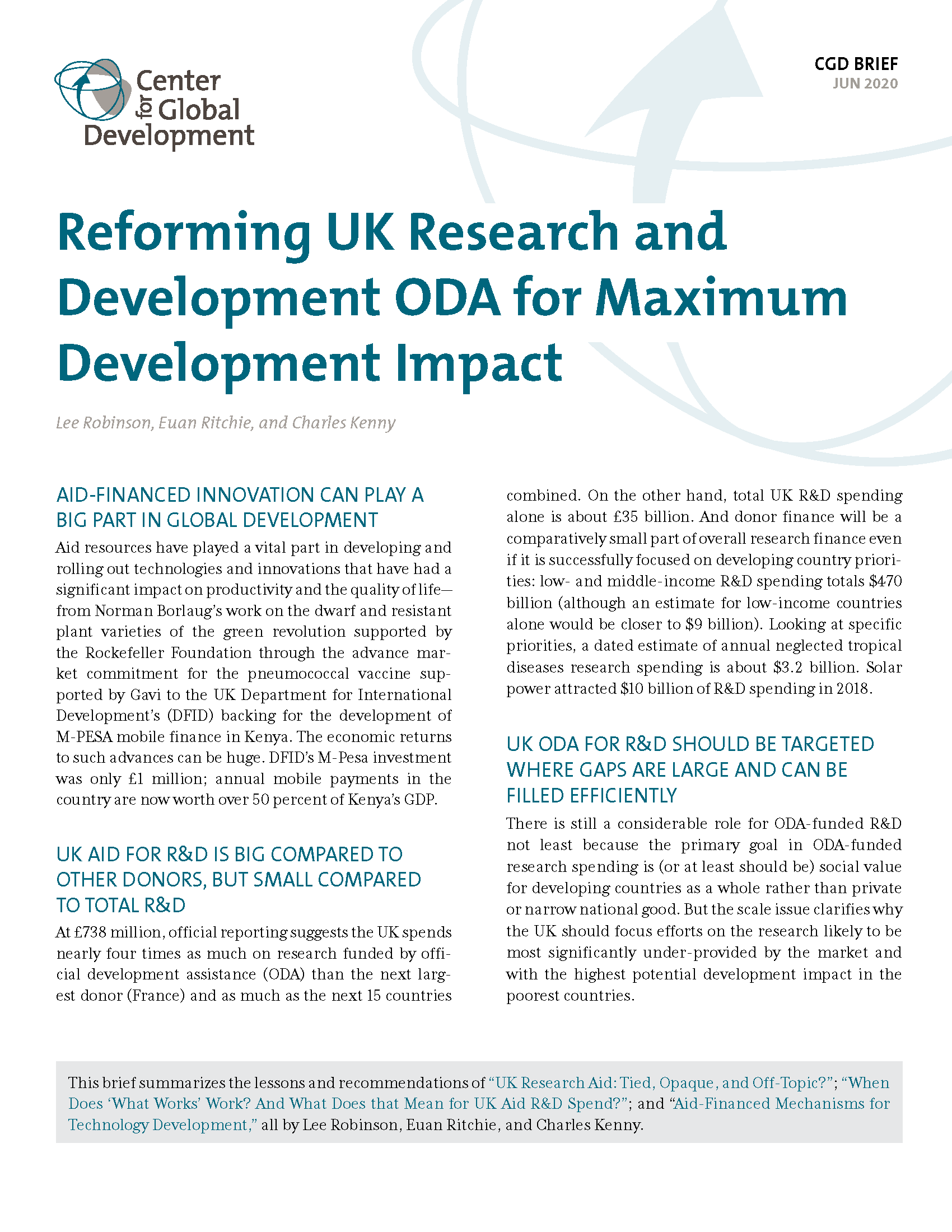Recommended

Blog Post
A new Independent Commission on Aid Impact (ICAI) report issued this week suggests that large parts of UK aid spending on research and development (R&D) remain hampered by a design that favors British researcher interests over urgent research topics and capacity prioritized by the world’s poorest countries. The next few months are a perfect opportunity to fix that problem, because the two most problematic funds are up for renewal.
The new ICAI review is a follow-up on a 2018-19 report discussing progress on implementing the Commission’s earlier recommendations including on research funded with official development assistance (ODA). It finds there have been some positive steps: the £735m Newton Fund has begun producing more detailed country strategy documents in cooperation with partner countries. And the £1,500m Global Challenges Research Fund (GCRF) has increased the involvement of developing country research institutions through the International Development Peer Review College, which (as it says on the box) help peer review GCRF proposals. The college aims to draw 90 percent of members from developing countries. At the same time, the ICAI report notes continuing problems with prioritizing the R&D needs and capacities of the world’s poorest countries over the interests and budgets of UK research institutions. For example:
“The Newton Fund’s funding model [of supporting UK costs for research partnerships] continues to be inconsistent with the spirit of the UK’s commitment to untie all aid since 2001. It channels UK aid through UK delivery partners, which then fund UK research institutions, while partner countries use their own resources to support their own institutions’ participation in the partnership.”
“The GCRF [quality-related, or QR] spending [effectively a top up of higher education institution budgets divorced from high-impact development research priorities] is also tied aid in spirit, in that it goes exclusively to UK institutions. These can choose to allocate some funding to a Southern partner, but they are not required to do so. Some [higher education institutions] use GCRF QR funding to meet full economic costs, including to cover overheads.”
We have written before about the considerable problems with the Newton Fund and the GCRF, as well as the Ayrton Fund. We’ve also suggested some reform proposals for UK ODA R&D expenditure. Conveniently, Newton and GCRF finish their funding cycles next year, which is when the Ayrton Fund is due to launch (see the table below). And, for the first time in many years, UK ODA is set to fall this year. Now is a perfect time to rethink these schemes to focus on impact.
Budget cycles for UK ODA-funded R&D
| Dates | £m | ||
|---|---|---|---|
| DHSC | Ross Fund | 2016 - ?? | 1000 |
| NIHR | 2016-2021 | 430 | |
| BEIS | GCRF | 2016-2021 | 1500 |
| Newton | 2015-2021 | 735 | |
| Ayrton | 2021-2026 | 1000 | |
| DFID | "DFID Research" (annual budget) | 2016-2021 | 1500 |
Note: DHSC= Department of Health and Social Care; BEIS=Department for Business, Energy, and Industrial Strategy; NIHR=National Institute for Health Research; DFID=Department for International Development.
Our preferred approach would be to re-house all ODA R&D currently managed by the Department for Business, Energy, and Industrial Strategy to the new Foreign, Commonwealth and Development Office, using a mechanism that sets priorities based on recipient country input, maximizes capacity building and spending in low- and lower-middle-income countries, and uses a range of different approaches to fund innovation from research partnerships through prizes. But the existing funding could be a lot better used even though a partial reform that would:
-
Change criteria and country focus for the Newton Fund towards lower-income countries and grant funding support of recipient partner institutions.
-
Abandon the QR component for the GCRF, significantly increase the role of the International Development Peer Review College in selecting GCRF research priorities and projects, and increase partnership requirements and support to recipient country institutions.
-
Establish a different design for the Ayrton Fund before launch. GCRF and Newton were scaled up quickly in response to the new legislation that mandated the increase to spending 0.7 percent of GNI on aid. Copying existing structures was the easy option in this context, but not the most impactful. No such pressure exists for Ayrton. An ODA fund dedicated to climate is indefensible if it is an excuse to hand ODA to UK universities. But if the fund consults with climate experts to identify different funding mechanisms that could really move the needle on technologies with a high development impact in poor countries that could also reduce emissions or ease adaptation related to climate change (perhaps including water desalination, clean stoves, or alternatives to crop-burning), then it could be transformative.
-
Set aside some part of all three funds for a recipient-led Advance Research Projects Agency for Development (ARPA-D) that would go for “development moon shots” and use innovative mechanisms. Again, the Development Peer Review College or an equivalent body could be used as the focusing and review mechanism for the ARPA-D institution. This is something the government has already committed to for broader research. The recently published “Research and Development Roadmap” emphasizes the need to “engage in new and imaginative ways” to ensure research has impact, and the proposed new body will “collaborate internationally, championing bold and transformative R&D.” Bold and transformative R&D is needed in development too, and as the government clearly recognizes, this can require a variety of funding mechanisms, not just grant funding through councils.
COVID-19 has demonstrated how important R&D is to global quality of life and development. R&D on public good issues of particular concern to low- and lower-middle-income countries is particularly lacking—as is support for R&D capacity in those countries. UK aid could have a real impact in response to these problems—but only if it is designed to do so. If not, it would be a suitable target for reductions in a period of aid austerity.
Disclaimer
CGD blog posts reflect the views of the authors, drawing on prior research and experience in their areas of expertise. CGD is a nonpartisan, independent organization and does not take institutional positions.







